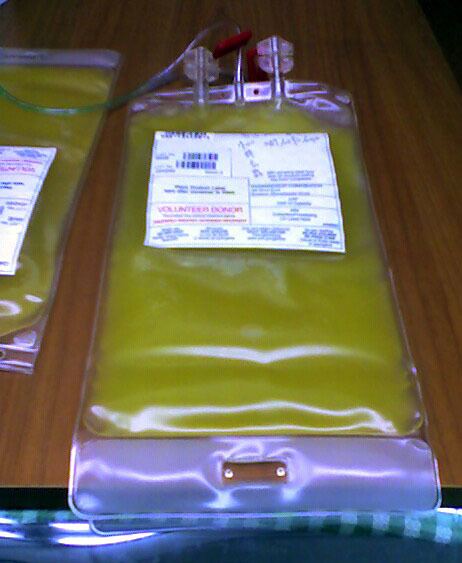ATC code B05A (WHO) | ||
 | ||
Platelet transfusion, also known as platelet concentrate, is used to treat or prevent bleeding in people with either a low platelet count or poor platelet function. Often this occurs in people receiving cancer chemotherapy. Preventative transfusion is often done in those with platelet levels of less than 10 x 109/L. In those who are bleeding transfusion is typically carried out at less than 50 x 109/L. Cross matching is typically required before platelets are given. They are given by injection into a vein.
Contents
Side effects can include allergic reactions such as anaphylaxis, infection, and lung injury. Bacterial infections are relatively more common with platelets as they are stored at warmer temperatures. Platelets can be gotten either from whole blood or by apheresis. They keep for up to five to seven days.
Platelet transfusions came into medical use in the 1950s and 1960s. It is on the World Health Organization's List of Essential Medicines, the most effective and safe medicines needed in a health system. In the United Kingdom it costs the NHS about 200 pounds per unit. Some versions of platelets have had the white blood cells partially removed or been gamma irradiated which have specific benefits for certain populations.
Medication use
International guidelines recommend that platelets transfusions are given to people with reversible bone marrow failure to reduce the risk of spontaneous bleeding when the platelet count is less than 10 x 109/L.
Prevention versus treatment
A review in people with haematological malignancies found that overall giving platelet transfusions when the platelet count is less than 10 x 109/L reduced the number of bleeding events and days with significant bleeding. However, this benefit was only seen in certain patient groups, and people undergoing an autologous stem cell transplant derived no obvious benefit.
Dose
A review in people with haematological malignancies compared different platelet transfusion doses. This review found no difference in the number of people who had clinically significant bleeding between platelet transfusions that contained a small number of platelets (low dose - 1.1 x 1011/m2) and those that contained an intermediate number of platelets (intermediate dose - 2.2 x 1011/m2). This review also found no difference in the number of people who had clinically significant bleeding between platelet transfusions that contained a small number of platelets and those that contained a large number of platelets (high dose - 4.4 x 1011/m2). One of the review's included studies reported on transfusion reactions. This study’s authors suggested that a high-dose platelet transfusion strategy may lead to a higher rate of transfusion-related adverse events.
Usage
People with cancer receive the largest proportion of platelet transfusions as they are an important supportive therapy during treatment with chemotherapy or stem cell transplant. Much of the remainder are used in general medicine, cardiac surgery and in intensive care.
Unlike other blood products demand for platelet transfusions appears to be increasing in several countries around the world. An ageing population, an increase in the number of people with blood cancer, and changes to the management of these cancers are likely the major reasons for the rise in demand for platelets. Since 1990, the number of stem cell transplants performed in Europe has risen from 4,200 to over 30,000 annually.
